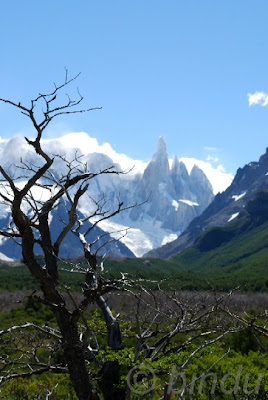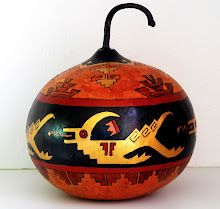I was in the World Market the other day, and saw this bag of lovely carved wooden balls. The whole bag was only $5, and the balls looked so pretty that I bought them and brought them home.

On closer inspection, upon reading the label inside the bag I realized that these balls were actually wood apples! I hadn't seen a wood apple (or bael fruit) in at least fifteen years, and hadn't ever seen any art using them. So this was an interesting surprise.
I did my entire schooling in a campus in South India where wood apple trees grow wild. As kids we have eaten these fruits in all stages of their growth. The shell of the wood apple is thick and hard, and we used to break the fruit open with a stone or by hurling it to the ground.
Here's a picture of a wood apple tree I found online:

While still raw, the inside is a green mass that is extremely sour, and it smears itself to the palate. I don't know why we would still persist at eating them at this stage! I guess when you are about 8 years old and have nothing else to do, this is good entertainment.
The ripe wood apple fruit is brown on the inside, and sticky with a sweet-sour taste. This is cooked into chutneys in India and rarely eaten as is, except by kids. :) These were hard to find because most kids had their eye on the same ripening fruit and I was rarely the one that got it. When I did though, it used to be a treat. Maybe the struggle to get it made it sweeter than it really was!
Here's a picture from Wiki of a ripe wood apple:

This fruit has a lot of good uses too: (info obtained from Wikipedia)
As food: Indonesians beat the pulp of the ripe fruit with palm sugar and eat the mixture at breakfast. The sweetened pulp is a source of sherbet in the subcontinent. Jam, pickle, marmalade, syrup, jelly, squash and toffee are some of the products of this versatile fruit. Young bael leaves are a salad green in Thailand.
Other uses: Bael fruit pulp has a soap-like action that made it a household cleaner for hundreds of years. The sticky layer around the unripe seeds is household glue that also finds use in jewelery-making. The glue, mixed with lime, waterproofs wells and cements walls. The glue also protects oil paintings when added as a coat on the canvas. The fruit rind yields oil that is popular as a fragrance for hair; it also produces a dye used to color silks and calico.
Nutrition: A hundred gm of bael fruit pulp contains 31 gm of carbohydrate and two gm of protein, which adds up to nearly 140 calories. The ripe fruit is rich in beta-carotene; it also contains significant quantities of the B vitamins thiamine and riboflavin, and small amounts of Vitamin C.
Medicinal uses: The bael fruit is more popular as medicine than as food. The tannin in bael has an astringent effect that once led to its use as a general tonic and as a traditional cure for dysentery, diarrhoea, liver ailments, chronic cough and indigestion. In fact, Vasco da Gama's men, suffering from diarrhoea and dysentery in India, turned to the bael fruit for relief. The root juice was once popular as a remedy for snakebites.
The seed oil is a purgative, and the leaf juice mixed with honey is a folk remedy for fever. The tannin-rich and alkaloid-rich bark decoction is a folk cure for malaria.
I wonder if any of you has seen other art using wood apples?Moving on to avocados ...
I've read in several places that it's easy to grow avocado plants from the pit of the fruit. The process and the plant look so interesting and beautiful in the pictures online that I've tried multiple times to get this to work. I've never been successful.
But that doesn't stop me from trying! I made some guacamole over the weekend, and once again, I have suspended the two pits in water in the hope that they will grow into gorgeous indoor plants one day. Wish me luck!

Have you ever got this to work? If you have, do tell me what I'm doing wrong!
 Enjoy your week!
Enjoy your week!


































